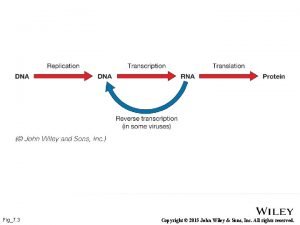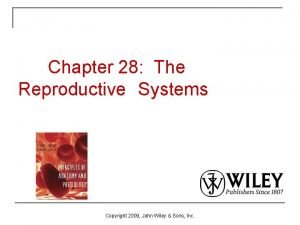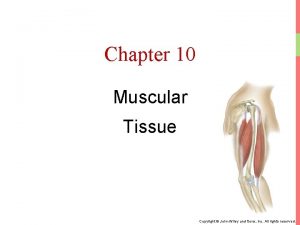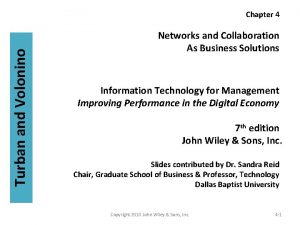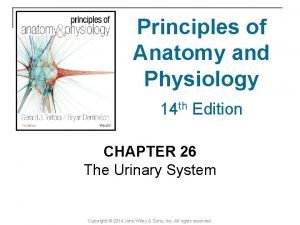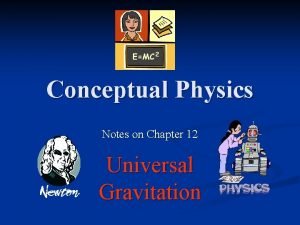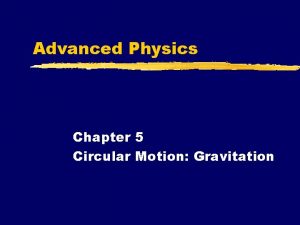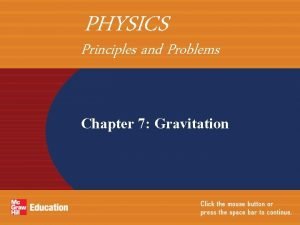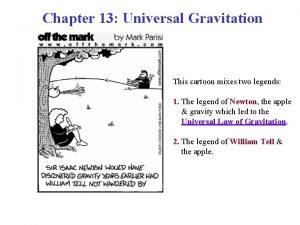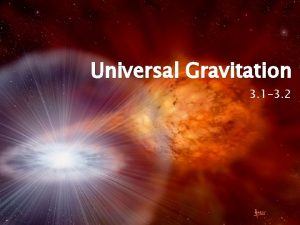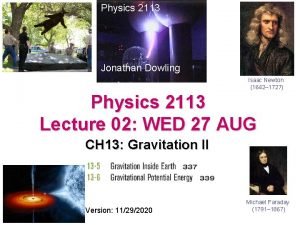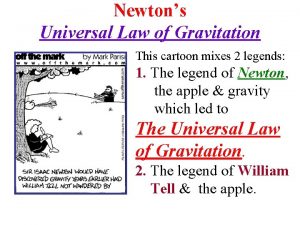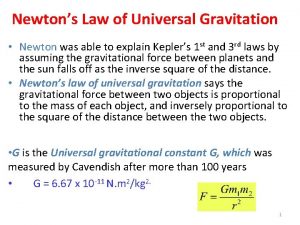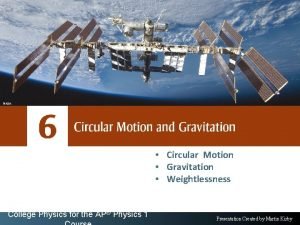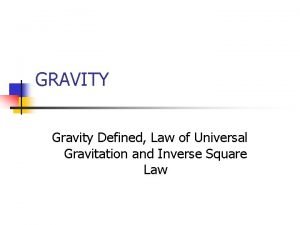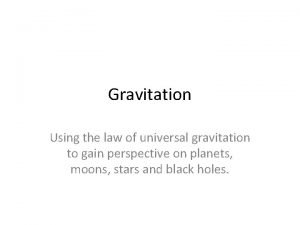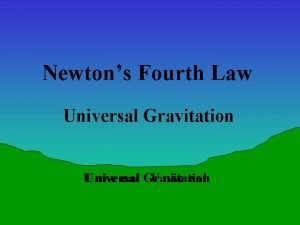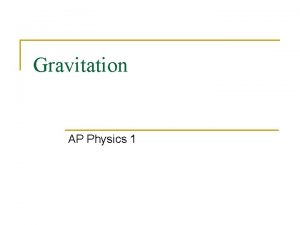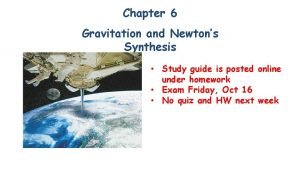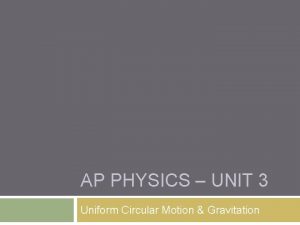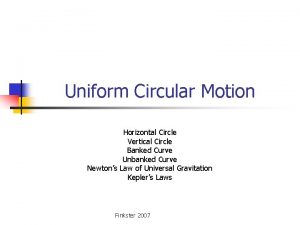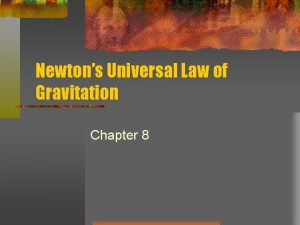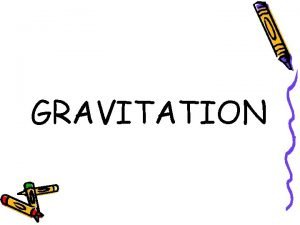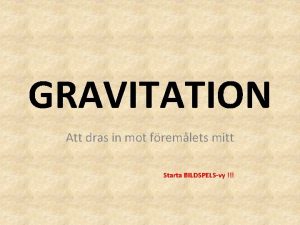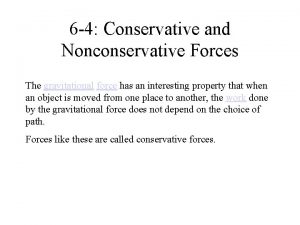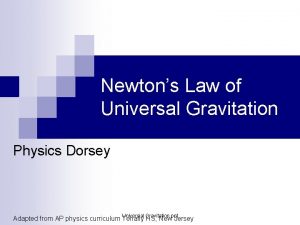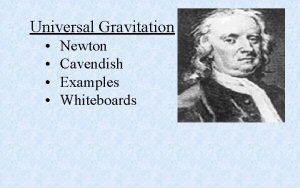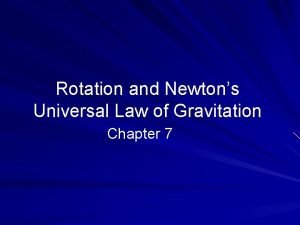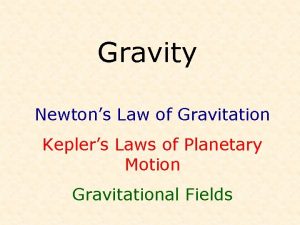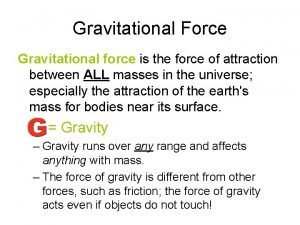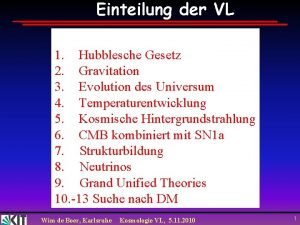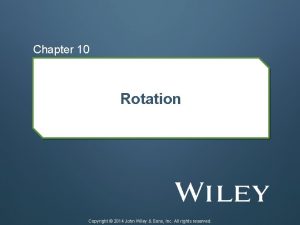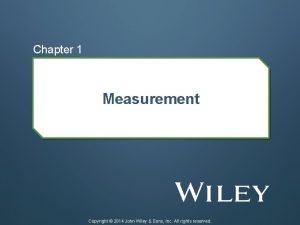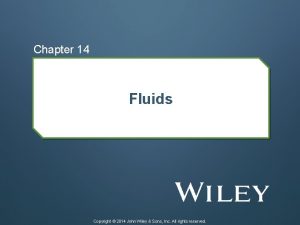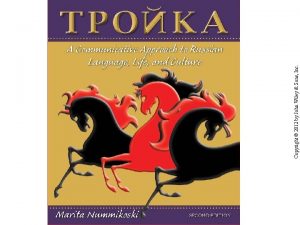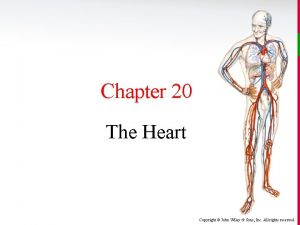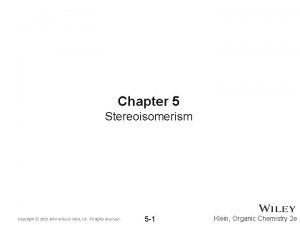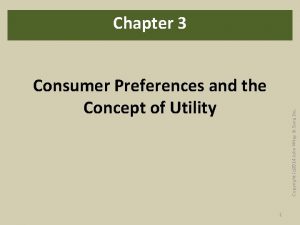Chapter 13 Gravitation Copyright 2014 John Wiley Sons










































- Slides: 42

Chapter 13 Gravitation Copyright © 2014 John Wiley & Sons, Inc. All rights reserved.

13 -1 Newton's Law of Gravitation Learning Objectives 13. 01 Apply Newton's law of gravitation to relate the gravitational force between two particles to their masses and their separation. 13. 02 Identify that a uniform spherical shell of matter attracts a particle that is outside the shell as if all the shell's mass were concentrated as a particle at its center. 13. 03 Draw a free-body diagram to indicate the gravitational force on a particle due to another particle or a uniform, spherical distribution of matter. © 2014 John Wiley & Sons, Inc. All rights reserved.

13 -1 Newton's Law of Gravitation The gravitational force o Holds us to the Earth o Holds Earth in orbit around the Sun o Holds the Sun together with the stars in our galaxy o Reaches out across intergalactic space to hold together the Local Group of galaxies o Holds together the Local Supercluster of galaxies o Pulls the supercluster toward the Great Attractor o Attempts to slow the expansion of the universe o Is responsible for black holes Gravity is far-reaching and very important! © 2014 John Wiley & Sons, Inc. All rights reserved.

13 -1 Newton's Law of Gravitational attraction depends on the amount of “stuff” an object is made of Earth has lots of “stuff” and produces a large attraction The force is always attractive, never repulsive Gravitation is the tendency for bodies to attract each other Newton realized this attraction was responsible for maintaining the orbits of celestial bodies Newton's law of gravitation defines the strength of this attractive force between particles For apple & Earth: 0. 8 N; for 2 people: < 1 μN © 2014 John Wiley & Sons, Inc. All rights reserved.

13 -1 Newton's Law of Gravitation The magnitude of the force is given by: Eq. (13 -1) Where G is the gravitational constant: Eq. (13 -2) The force always points from one particle to the other, so this equation can be written in vector form: Eq. (13 -3) © 2014 John Wiley & Sons, Inc. All rights reserved.

13 -1 Newton's Law of Gravitation The shell theorem describes gravitational attraction for objects Earth is a nesting of shells, so we feel Earth's mass as if it were all located at its center Gravitational force forms third-law force pairs E. g. , Earth-apple and apple-Earth forces are both 0. 8 N Figure 13 -2 © 2014 John Wiley & Sons, Inc. All rights reserved.

13 -1 Newton's Law of Gravitation The difference in mass causes the difference in the apple: Earth accelerations: ~10 m/s 2 vs. ~ 10 -25 m/s 2 Figure 13 -3 Answer: All exert equal forces on the particle © 2014 John Wiley & Sons, Inc. All rights reserved.

13 -2 Gravitation and the Principle of Superposition Learning Objectives 13. 04 If more than one gravitational force acts on a particle, draw a free-body diagram showing those forces, with the tails of the force vectors anchored on the particle. 13. 05 If more than one gravitational force acts on a particle, find the net force by adding the individual forces as vectors. © 2014 John Wiley & Sons, Inc. All rights reserved.

13 -2 Gravitation and the Principle of Superposition Find the net gravitational force by the principle of superposition: the net is the sum of individual effects Add the individual forces as vectors: Eq. (13 -5) For a real (extended) object, this becomes an integral: Eq. (13 -6) If the object is a uniform sphere or shell we can treat its mass as being at its center instead © 2014 John Wiley & Sons, Inc. All rights reserved.

13 -2 Gravitation and the Principle of Superposition Example Summing two forces: Figure 13 -4 © 2014 John Wiley & Sons, Inc. All rights reserved.

13 -2 Gravitation and the Principle of Superposition Answer: (a) 1, 2 & 4, 3 (b) line of length d © 2014 John Wiley & Sons, Inc. All rights reserved.

13 -3 Gravitation Near Earth's Surface Learning Objectives 13. 06 Distinguish between the free-fall acceleration and the gravitational acceleration. 13. 07 Calculate the gravitational acceleration near but outside a uniform, spherical astronomical body. 13. 08 Distinguish between measured weight and the magnitude of the gravitational force. © 2014 John Wiley & Sons, Inc. All rights reserved.

13 -3 Gravitation Near Earth's Surface Combine F = GMm/r 2 and F = mag: Eq. (13 -11) This gives the magnitude of the gravitational acceleration at a given distance from the center of the Earth Table 13 -1 shows the value for ag for various altitudes above the Earth’s surface Table 13 -1 © 2014 John Wiley & Sons, Inc. All rights reserved.

13 -3 Gravitation Near Earth's Surface The calculated ag will differ slightly from the measured g at any location Therefore the calculated gravitational force on an object will not match its weight for the same 3 reasons: 1. Earth's mass is not uniformly distributed, Fig. 13 -5 2. Earth is not a sphere 3. Earth rotates Figure 13 -5 © 2014 John Wiley & Sons, Inc. All rights reserved.

13 -3 Gravitation Near Earth's Surface Example Difference in gravitational force and weight due to rotation at the equator: Eq. (13 -12) Eq. (13 -14) Figure 13 -6 © 2014 John Wiley & Sons, Inc. All rights reserved.

13 -4 Gravitation Inside Earth Learning Objectives 13. 09 Identify that a uniform shell of material exerts no net gravitational force on a particle located inside it. 13. 10 Calculate the gravitational force that is exerted on a particle at a given radius inside a nonrotating uniform sphere of matter. © 2014 John Wiley & Sons, Inc. All rights reserved.

13 -4 Gravitation Near Earth's Surface The shell theorem also means that: Forces between elements do not disappear, but their vector sum is 0 Let's find the gravitational force inside a uniformdensity Earth a solid sphere, not a shell: Eq. (13 -17) Figure 13 -7 © 2014 John Wiley & Sons, Inc. All rights reserved.

13 -4 Gravitation Near Earth's Surface The constant density is: Substitute in to Eq. 13 -17: Eq. (13 -19) If we write this as a vector equation, substituting K for the constants: Eq. (13 -20) Object dropped through Earth oscillates (Hooke's law) © 2014 John Wiley & Sons, Inc. All rights reserved.

13 -5 Gravitational Potential Energy Learning Objectives 13. 11 Calculate the gravitational potential energy of a system of particles (or uniform spheres that can be treated as particles). 13. 12 Identify that if a particle moves from an initial to a final point while experiencing a gravitational force, the work done by that force (and thus the change in gravitational potential energy) is independent of which path is taken. 13. 13 Using the gravitational force on a particle near an astronomical body (or some second body that is fixed in place), calculate the work done by the force when the body moves. 13. 14 Apply the conservation of mechanical energy (including gravitational potential energy) to a particle moving relative to an astronomical body (or some second body that is fixed in place). © 2014 John Wiley & Sons, Inc. All rights reserved.

13 -5 Gravitational Potential Energy 13. 15 Explain the energy 13. 16 Calculate the escape requirements for a speed of a particle in particle to escape from an leaving an astronomical body. (assumed to be a uniform sphere). © 2014 John Wiley & Sons, Inc. All rights reserved.

13 -5 Gravitational Potential Energy Note that gravitational potential energy is a property of a pair of particles We cannot divide it up to say how much of it “belongs” to each particle in the pair We often speak as of the “gravitational potential energy of an baseball” in the ball-Earth system We get away with this because the energy change appears almost entirely as kinetic energy of the ball This is only true for systems where one object is much less massive than the other © 2014 John Wiley & Sons, Inc. All rights reserved.

13 -5 Gravitational Potential Energy Gravitational potential energy for a two-particle system is written: Eq. (13 -21) Note this value is negative and approaches 0 for r → ∞ The gravitational potential energy of a system is the sum of potential energies for all pairs of particles Eq. (13 -22) Figure 13 -8 © 2014 John Wiley & Sons, Inc. All rights reserved.

13 -5 Gravitational Potential Energy The gravitational force is conservative The work done by this force does not depend on the path followed by the particles, only the difference in the initial and final positions of the particles Since the work done is independent of path, so is the gravitational potential energy change Eq. (13 -26) Figure 13 -10 © 2014 John Wiley & Sons, Inc. All rights reserved.

13 -5 Gravitational Potential Energy Newton's law of gravitation can be derived from the potential energy formula by taking the derivative For a projectile to escape the gravitational pull of a body, it must come to rest only at infinity, if at all At rest at infinity: K = 0 and U = 0 (because r → ∞) So K + U must be at least 0 at the surface of the body: Eq. (13 -28) Rockets launch eastward to take advantage of Earth's rotational speed, to reach v more easily © 2014 John Wiley & Sons, Inc. All rights reserved.

13 -5 Gravitational Potential Energy Table 13 -2 Answer: (a) increases (b) negative work © 2014 John Wiley & Sons, Inc. All rights reserved.

13 -6 Planets and Satellites: Kepler's Laws Learning Objectives 13. 17 Identify Kepler's three laws. 13. 18 Identify which of Kepler's laws is equivalent to the law of conservation of angular momentum. 13. 19 On a sketch of an elliptical orbit, identify the semimajor axis, the eccentricity, the perihelion, the aphelion, and the focal points. 13. 20 For an elliptical orbit, apply the relationships between the semimajor axis, the eccentricity, the perihelion, and the aphelion. 13. 21 For an orbiting natural or artificial satellite, apply Kepler's relationship between the orbital period and radius and the mass of the astronomical body being orbited. © 2014 John Wiley & Sons, Inc. All rights reserved.

13 -6 Planets and Satellites: Kepler's Laws The motion of planets in the solar system was a puzzle for astronomers, especially curious motions such as in Figure 13 -11 Johannes Kepler (1571 -1630) derived laws of motion using Tycho Brahe's (1546 -1601) measurements Figure 13 -11 © 2014 John Wiley & Sons, Inc. All rights reserved. Figure 13 -12

13 -6 Planets and Satellites: Kepler's Laws The orbit is defined by its semimajor axis a and its eccentricity e An eccentricity of zero corresponds to a circle Eccentricity of Earth's orbit is 0. 0167 Equivalent to the law of conservation of angular momentum © 2014 John Wiley & Sons, Inc. All rights reserved.

13 -6 Planets and Satellites: Kepler's Laws Figure 13 -13 The law of periods can be written mathematically as: Eq. (13 -34) Holds for elliptical orbits if we replace r with a © 2014 John Wiley & Sons, Inc. All rights reserved.

13 -6 Planets and Satellites: Kepler's Laws Table 13 -3 Answer: (a) satellite 2 (b) satellite 1 © 2014 John Wiley & Sons, Inc. All rights reserved.

13 -7 Satellites: Orbits and Energy Learning Objectives 13. 22 For a satellite in a circular orbit around an astronomical body, calculate the gravitational potential energy, the kinetic energy, and the total energy. 13. 23 For a satellite in an elliptical orbit, calculate the total energy. © 2014 John Wiley & Sons, Inc. All rights reserved.

13 -7 Satellites: Orbits and Energy Relating the centripetal acceleration of a satellite to the gravitational force, we can rewrite as energies: Eq. (13 -38) Meaning that: Eq. (13 -39) Therefore the total mechanical energy is: Eq. (13 -40) © 2014 John Wiley & Sons, Inc. All rights reserved.

13 -7 Satellites: Orbits and Energy Total energy E is the negative of the kinetic energy For an ellipse, we substitute a for r Therefore the energy of an orbit depends only on its semimajor axis, not its eccentricity All orbits in Figure 13 -15 have the same energy Figure 13 -15 Figure 13 -16 © 2014 John Wiley & Sons, Inc. All rights reserved.

13 -7 Satellites: Orbits and Energy Answer: (a) orbit 1, since the energy has decreased (b) the semimajor axis has decreased, so the period decreases © 2014 John Wiley & Sons, Inc. All rights reserved.

13 -8 Einstein and Gravitation Learning Objectives 13. 24 Explain Einstein's principle of equivalence. 13. 25 Identify Einstein's model for gravitation as being due to the curvature of spacetime. © 2014 John Wiley & Sons, Inc. All rights reserved.

13 -8 Einstein and Gravitation The general theory of relativity describes gravitation Its fundamental postulate is the principle of equivalence Gravitation and acceleration are equivalent The experimenter inside this box is unable to tell whether he is on Earth experiencing g = 9. 8 m/s 2, or in free space accelerating at 9. 8 m/s 2. Figure 13 -18 © 2014 John Wiley & Sons, Inc. All rights reserved.

13 -8 Einstein and Gravitation Space (spacetime) is curved Analogies: In (a) and (b), paths that appear to be parallel, along the surface of the Earth or falling toward the Earth's center, actually converge We can see why by stepping “outside” the curved Earth, but we can't step “outside” of curved space © 2014 John Wiley & Sons, Inc. All rights reserved. Figure 13 -19

13 -8 Einstein and Gravitation But we can observe the curvature of space Light bends as it passes by massive objects: an effect called gravitational lensing In extreme cases we observe the light coming from multiple places, or bent into an Einstein ring Figure 13 -20 © 2014 John Wiley & Sons, Inc. All rights reserved.

13 -8 Einstein and Gravitation The source of gravitation, however, is still unclear Is it purely an effect of curved spacetime? Is it a force between masses? Is it due to a fundamental particle, the graviton, which would carry the gravitational force? These questions are not yet settled © 2014 John Wiley & Sons, Inc. All rights reserved.

13 Summary The Law of Gravitation Eq. (13 -1) Gravitational Behavior of Uniform Spherical Shells The net force on an external object: calculate as if all the mass were concentrated at the center of the shell Eq. (13 -2) Superposition Gravitational Acceleration Eq. (13 -5) © 2014 John Wiley & Sons, Inc. All rights reserved. Eq. (13 -11)

13 Summary Free-Fall Acceleration and Weight Earth's mass is not uniformly distributed, the planet is not spherical, and it rotates: the calculated and measured values of acceleration differ Gravitational Potential Energy Gravitation within a Spherical Shell A uniform shell exerts no net force on a particle inside Inside a solid sphere: Eq. (13 -19) Potential Energy of a System Eq. (13 -21) Eq. (13 -22) © 2014 John Wiley & Sons, Inc. All rights reserved.

13 Summary Escape Speed Kepler's Laws Eq. (13 -28) The law of orbits: ellipses The law of areas: equal areas in equal times The law of periods: Eq. (13 -34) Energy in Planetary Motion Kepler's Laws Eq. (13 -42) Gravitation and acceleration are equivalent General theory of relativity explains gravity in terms of curved space © 2014 John Wiley & Sons, Inc. All rights reserved.
 John wiley & sons, incorporated
John wiley & sons, incorporated Pudendum
Pudendum Chapter 10 muscle tissue
Chapter 10 muscle tissue John wiley & sons, inc.
John wiley & sons, inc. Klein organic chemistry 2nd edition
Klein organic chemistry 2nd edition John wiley and sons
John wiley and sons Juxtaglomerular apparatus
Juxtaglomerular apparatus There was a man who had four son
There was a man who had four son A man had four sons
A man had four sons John wiley
John wiley Copyright 2014 pearson education inc
Copyright 2014 pearson education inc Conceptual physics chapter 13 universal gravitation
Conceptual physics chapter 13 universal gravitation Chapter 5 circular motion gravitation
Chapter 5 circular motion gravitation Chapter 7 study guide physics
Chapter 7 study guide physics Cartoon law of universal gravitation
Cartoon law of universal gravitation Explain newton’s universal law of attraction/gravitation.
Explain newton’s universal law of attraction/gravitation. Gauss law in gravitation
Gauss law in gravitation Universal gravity constant
Universal gravity constant Universal gravity constant
Universal gravity constant Newton's law of gravitation
Newton's law of gravitation Martin kirby physics
Martin kirby physics Formula of potential and kinetic energy
Formula of potential and kinetic energy Universal gravitation law
Universal gravitation law Angular velocity to tangential velocity
Angular velocity to tangential velocity Universal gravitation law
Universal gravitation law Universal law of gravitation calculator
Universal law of gravitation calculator What is newton's fourth law
What is newton's fourth law Newton's universal law of gravitation ap physics 1
Newton's universal law of gravitation ap physics 1 Gravitation and newton's synthesis
Gravitation and newton's synthesis Ap physics unit 3 circular motion and gravitation
Ap physics unit 3 circular motion and gravitation Vertical circle and horizontal circle
Vertical circle and horizontal circle Newton's universal law of gravitation simplified
Newton's universal law of gravitation simplified Gravitation is a natural phenomenon where:
Gravitation is a natural phenomenon where: Gravitation enhet
Gravitation enhet The force of gravitation is conservative or nonconservative
The force of gravitation is conservative or nonconservative Law of universal gravitation ppt
Law of universal gravitation ppt Law of universal gravitation kid definition
Law of universal gravitation kid definition State newton's law of gravitation
State newton's law of gravitation Gravitation
Gravitation Effect of gravitational force
Effect of gravitational force Gravitation scheinkraft
Gravitation scheinkraft Onlinelibrary-wiley-com
Onlinelibrary-wiley-com Jay shurley
Jay shurley
